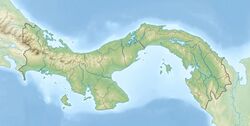Earth:Culebra Formation
From HandWiki
| Culebra Formation Stratigraphic range: Aquitanian-Burdigalian (Late Arikareean-Hemingfordian) 23–19 Ma | |
|---|---|
| Type | Formation |
| Sub-units | Emperador Limestone |
| Underlies | Cucaracha Formation |
| Overlies | Las Cascadas Formation |
| Thickness | > 250 m (820 ft) |
| Lithology | |
| Primary | Sandstone, limestone, mudstone, shale |
| Other | Siltstone, conglomerate, lignite |
| Location | |
| Coordinates | [ ⚑ ] : 9°06′N 79°42′W / 9.1°N 79.7°W |
| Paleocoordinates | [ ⚑ ] 8°24′N 77°30′W / 8.4°N 77.5°W |
| Region | Colón Province |
| Country | |
| Extent | Panama Basin |
| Type section | |
| Named for | Culebra Cut |
The Culebra Formation (Tcb)[1] is a geologic formation in Panama. It preserves fossils dating back to the Miocene period; Early Miocene epoch, Aquitanian to Burdigalian stages (Late Arikareean to Hemingfordian in the NALMA classification).[2] Fossils of Culebrasuchus have been found in and named after the formation.[3] The thickness of the formation is at least 250 metres (820 ft) thick,[4] and the age has been estimated as from 23 to 19 Ma.[5]
Fossil content
- Culebrasuchus mesoamericanus[3][6]
- Culebratherium alemani[7]
- Dentimides[8]
- Panamacebus transitus[9][10]
- Paratoceras orarius[11]
- Purussaurus
- Podocnemididae indet.[12]
See also
- List of fossiliferous stratigraphic units in Panama
- Cucaracha Formation
- Gatún Formation
References
- ↑ Geologic Map, 1980
- ↑ Culebra Formation at Fossilworks.org
- ↑ 3.0 3.1 Culebrasuchus at Fossilworks.org
- ↑ Kirby et al., 2008, p.7
- ↑ Kirby et al., 2008, p.11
- ↑ Hastings et al., 2013
- ↑ Vélez Juarbe & Wood, 2019
- ↑ Landau et al., 2016
- ↑ Silvestro, 2017, p.14
- ↑ Panamacebus at Fossilworks.org
- ↑ Rincón et al., 2015
- ↑ Cadena et al., 2012, p.549
Bibliography
- Cadena, E.; J.R. Bourque; A.F. Rincón; J.I. Bloch; C.A. Jaramillo, and B.J. MacFadden. 2012. New turtles (Chelonia) from the late Eocene through Late Miocene of the Panama Canal Basin. Journal of Paleontology 86. 539–557. Accessed 2019-02-09.
- Alexander K. Hastings; Jonathan I. Bloch; Carlos A. Jaramillo; Aldo F. Rincon; Bruce J. Macfadden (2013). "Systematics and biogeography of crocodylians from the Miocene of Panama". Journal of Vertebrate Paleontology 33 (2): 239–263. doi:10.1080/02724634.2012.713814. Bibcode: 2013JVPal..33..239H.
- Kirby, Michael Xavier; Douglas S. Jones, and Bruce J. MacFadden. 2008. Lower Miocene Stratigraphy along the Panama Canal and Its Bearing on the Central American Peninsula. PLoS ONE 3. 1–14. Accessed 2019-02-09.
- Bernard Manuel Landau; Carlos Marques da Silva; Antoine Heitz (2016). "Systematics of the gastropods of the lower-middle Miocene Cantaure Formation, Paraguaná Peninsula, Venezuela". Bulletins of American Paleontology 389–390: 1–581. https://www.priweb.org/downloads/pubs/item_pdf_5807.pdf. Retrieved 2019-02-05.
- Aldo F. Rincon; Jonathan I. Bloch; Bruce J. Macfadden; Carlos A. Jaramillo (2015). "New early Miocene protoceratids (Mammalia, Artiodactyla) from Panama". Journal of Vertebrate Paleontology 35 (5): e970688. doi:10.1080/02724634.2015.970688. Bibcode: 2015JVPal..35E0688R.
- Silvestro, Daniele; Marcelo F. Tejedor; Martha L. Serrano Serrano; Oriane Loiseau; Victor Rossier; Jonathan Rolland; Alexander Zizka; Alexandre Antonelli, and Nicolas Salamin. 2017. Evolutionary history of New World monkeys revealed by molecular and fossil data. BioRxiv _. 1–32. Accessed 2017-09-24.
- Stewart, R.H.; J.L. Stewart, and W.P. Woodring. 1980. Geologic Map of the Panama Canal and Vicinity, 1. USGS. Accessed 2019-02-09.
- Vélez Juarbe, Jorge, and Aaron R. Wood. 2019. An early Miocene dugongine (Sirenia: Dugongidae) from Panama. Journal of Vertebrate Paleontology e1511799. Online edition. Accessed 2019-02-22.
- Woodring, W.P. 1957. Geology and Paleontology of Canal Zone and Adjoining Parts of Panama - 306A Geology and description of Tertiary mollusks (Gastropods: Trochidae to Turritellidae), 1–186. USGS. Accessed 2019-02-09.
Further reading
- B. J. MacFadden, M. X. Kirby, A. Rincon, C. Montes, S. Moron, N. Strong, and C. Jaramillo. 2010. Extinct peccary "Cynorca" occidentale (Tayassuidae, Tayassuinae) from the Miocene of Panama and correlations to North America. Journal of Paleontology 84(2):288-298
- C. Pimiento, G. González Barba, A.J.W. Hendy, C. Jaramillo, B. J. MacFadden, C. Montes, S. C. Suarez and M. Shippritt. 2013. Early Miocene chondrichthyans from the Culebra Formation Panama A window into marine vertebrate faunas before closure the Central American Seaway. Journal of South American Earth Sciences 42:159-170
 |


